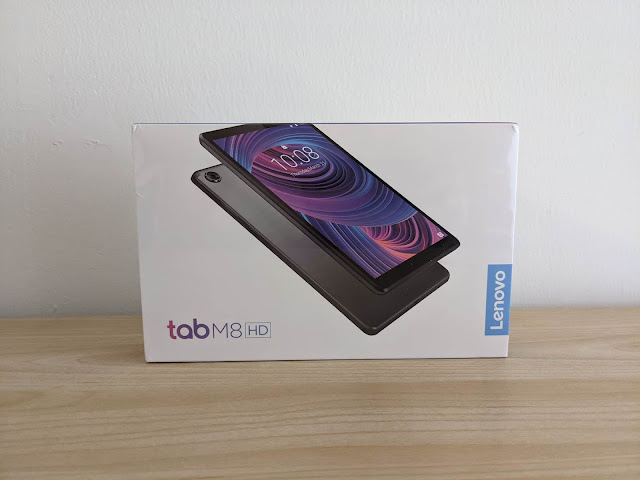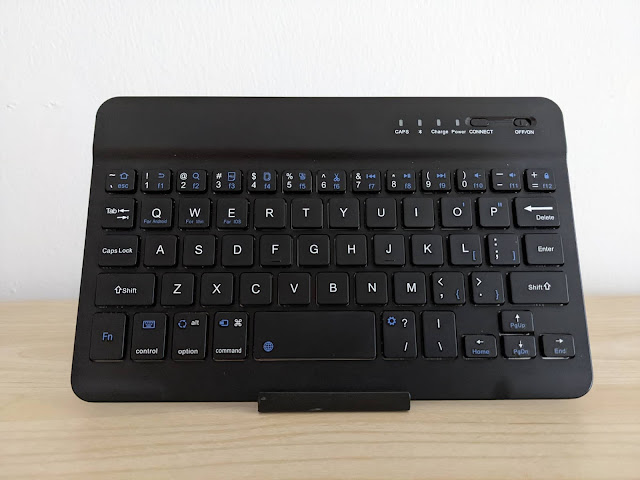Lenovo Tab M8 HD Review
I bought a Lenovo Tab M8 HD, an 8” Android tablet. It comes with a MediaTek Helio A22 SoC, an IPS panel, 2 GB of RAM, and 32 GB of storage. I ordered the device from Lenovo’s Italian online store for €134.
In this post I’ll share my early impressions on the device.
 |
| The packaging box of the Lenovo Tab M8 HD tablet. |
Motivation
The Lenovo Tab M8 HD replaces the Lenovo Tab E7 7” tablet I bought almost a year and a half earlier.
After enjoying the Google Nexus 7 2012 and 2013 tablets I left Android slates for several years. My return to tablets with the November 2019 purchase of the cheap Lenovo Tab E7 was a sort of impulse buy. I wanted an affordable Android slate small enough to be compact but with a large enough screen to help productivity. I also figured it would double as an ebook reading device and let me explore the Android ecosystem.
The Tab E7 was nice but limited. The screen didn’t have good touch sensitivity, performance was poor, there was a lot of lag, and the screen was not large enough to read PDF files in vertical orientation.
Some time later I decided to researche Lenovo’s latest tablet lineup and, again as an impulse buy, I picked up the Tab M8 HD as an upgrade from the Tab E7. I went with the Tab M8 for its better specs, larger screen, and affordability.
Hardware
The Tab M8 HD is a low-end product but the metal case gives the tablet a nice premium feel. The device is well balanced. Holding it gives the impression it’s slightly lighter than the Tab E7 despite weighing slightly more.
The screen is bright and sharp thanks to the IPS panel. Although the 1280x800 resolution and the 8” screen are supposed to make the pixels visible if you come close enough, I’m unable to make out any appreciable pixelation. Perhaps it helps that I'm not eagle-eyed.
 |
| The Lenovo Tab M8 HD tablet on a stand. |
The Tab E7 had terrible touch sensitivity. The Tab M8 HD is in a different league, with its panel rarely missing a touch. It’s perhaps even too sensitive. When holding the tablet, the thin bezel often makes my fingers inadvertently touch some user interface element.
Performance is impressive considering the specs.
The new tablet is significantly more responsive than the Tab E7, which puts the Tab M8 HD in a class closer to my Pixel 4 XL phone than the Tab E7. Lag is consistently low and the device is snappy enough no matter what processing load I throw at it. Even with intensive multitasking I haven’t been able to fill the RAM for more than 80%.
The 16 GB of storage of the Tab E7 was never a limitation as I filled up only about half of that. Still, it’s great my Tab M8 HD comes with 32 GB of storage. This gives me ample margin to install interesting apps without thinking twice.
At home I have a 1 GB down/200 Mbps up fiber Internet connection. With the Tab E7 I could reach about 20 Mbps up/down over Wi-Fi. The Tab M8 HD peaks at 120 Mbps, 6X as much. Web surfing is fluid and contributes to a snappier experience. For comparison, my Pixel 4 XL reaches peaks of 300-350 Mbps down and 150-200 Mbps up over the same LAN.
Although definitely not flagship-class, the 5 MP rear and the 2 MP front cameras aren’t too bad when shooting well-lit scenes or subjects. Way better than the blurry shots with washed out colors the Tab E7 turned out.
 |
| A photo of an Android figurine I took with the rear camera of the Lenovo Tab M8 HD. |
Battery usage is equally impressive. Lenovo rates the battery life at 18 hours. However, a full charge lasts me 28-30 hours over 4-5 days of typical usage, with 10-12 hours of Screen on Time (SoT). Long enough not to have to reach for the charger often. Again, this is closer to the battery time of my Pixel 4 XL that goes on for 4-5 days of ordinary usage.
To me sound is the least important feature of an Android device as I don’t listen to too much music or audio. The Tab M8 HD audio is serviceable but definitely not at the level of quality advanced users and audiophiles demand.
For the Tab E7 I bought a very cheap Bluetooth keyboard that comes with a small stand to hold a device. Along with my Pixel 4 XL, the keyboard works well with the Tab M8 HD too.
Software
The Lenovo Tab M8 HD runs Android 10. It’s full Android, not a tightened build for resource-constrained devices like Android Go the Tab E7 had. Therefore, on the Tab M8 HD I have all the recent Android features, including true multitasking and split-window mode.
 |
| The home screen of my Lenovo Tab M8 HD with Android 10. |
It’s a clean Android with essentially the same stock Google experience of Pixel phones. There are a few minor differences such as a custom launcher (with Google Discover) and camera app, a handful of pre-installed apps (e.g. a mixer, a sound recorder), and Lenovo-specific system settings. The Tab E7 came with a couple of preloaded games that could be uninstalled. The Tab M8 HD doesn’t have any pre-installed games.
Unlike the Tab E7 with Android Go, which got security patches every couple of months, so far I have received no system updates or security patches for the Tab M8 HD. It’ll be interesting to see how often, if at all, Lenovo ships software updates for its non-Go Android devices.
Usage experience
Thanks to a combination of hardware, software, and design, the Lenovo Tab M8 HD is a joy to use. I always look forward to turning it on and playing with it a bit.
The Tab M8 HD is at a sweet spot where hardware specifications and performance fade into the background and I can just use the system without minding the device, or bumping into limitations or slowdowns.
The 8” screen makes the Tab M8 HD also a good ebook reading device. It’s the minimum size to comfortably read in vertical orientation PDF files, fixed-layout ebooks, or re-flowable ebooks with wide source code lines. The extra inch makes a difference compared with the Tab E7, on which the text of PDF files was barely large enough to be legible but not enough for sustained reading sessions.
Conclusion
I love the Lenovo Tab M8 HD; I nailed the purchase.
Although an external keyboard allows some creation work, the tablet is the perfect content consumption device. Not just media, but also the full range of ebook formats, from re-flowable formats to fixed-layout ones.
The pleasant experience with my Lenovo tablets is reassuring. It hints there’s still choice in the Android slate space and the success of the Kindle Fire leaves room for good and affordable Android tablets.

